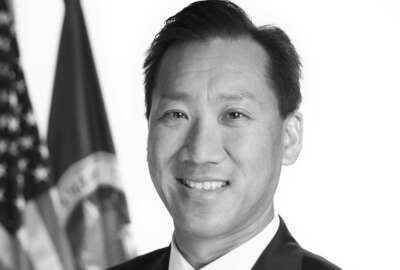Biden administration details initial vision, three top priorities under President’s Management Agenda
The Biden administration on Thursday described three broad priorities and several underlying strategies that will inform the President's Management Agenda. It will...
The Biden administration on Thursday laid out the vision for its President’s Management Agenda, detailing three broad goals and four values that will drive a multi-year, multi-faceted effort throughout the government.
The initial vision is a roadmap that explains how the administration will build capacity within government agencies to make good on the president’s broader agenda, Jason Miller, deputy director for management at the Office of Management and Budget, said.
“The how matters. This president has been clear from day one that how we do things shapes what we can do,” Miller told reporters Wednesday evening.
To that end, the Biden administration said values of equity, dignity, accountability and results would drive its PMA priorities. Each priority has multiple underlying strategies.
Those priorities are:
- Strengthening and empowering the federal workforce
- Delivering excellent, equitable and secure federal services and customer experiences
- Managing the business of government to “build back better”
“This simple, yet powerful three-part approach builds on lessons learned across administrations, while also repairing damage done over time to the federal government, by strengthening its capacity to deliver results,” Miller said.
The administration wanted to keep the PMA simple, and it explicitly wanted to avoid setting “dozens and dozens of new initiatives,” Miller added.
OMB and the President’s Management Council will identify leaders and teams for each priority and strategy area, who will set clear goals and report progress along the way on Performance.gov.
The administration will roll out the specifics for some of these initiatives in the coming weeks and months, Miller added. OMB will release cross-agency priority goals in early 2022, and individual agencies are deploying their own strategic plans and two-year priority goals that build on the PMA, according to the administration’s “vision” document.
Unlike PMAs from past administrations, the Biden team doesn’t specifically name IT modernization as a standalone priority, though it’s mentioned multiple times throughout documents explaining the vision.
“IT is an enabler across the entirety of this agenda, whether that’s powering our personnel systems and making sure we have the right tech talent in the federal government [or] strengthening our delivery systems,” Miller said.
Strengthening the workforce
In some ways, the priorities and strategies from the Biden administration are familiar. The Trump administration, for example, identified building a modern workforce as one of its three, overarching and cross-cutting PMA goals.
But while Trump focused more on finding ways to hold poor performers to account, the Biden administration’s agenda places union involvement and organizing front and center.
The pandemic is also clearly a thread throughout much of Biden’s workforce agenda, and it makes multiple references to the ways agencies will become more flexible, supportive employers by drawing on lessons and trends from the current moment. The Office of Personnel Management last week updated its telework guide and issued new advice for agencies on remote work.
To strengthen the workforce, the Biden administration named four strategies:
- Strategy 1: Attract and hire the most qualified employees, who reflect the diversity of our country, in the right roles across the federal government.
- Strategy 2: Make every federal job a good job, where all employees are engaged, supported, heard and empowered, with opportunities to learn, grow, join a union and have an effective voice in their workplaces through their union and thrive throughout their careers.
- Strategy 3: Reimagine and build a roadmap to the future of federal work informed by lessons from the pandemic and nationwide workforce and workplace trends.
- Strategy 4: Build the personnel system and support required to sustain the federal government as a model employer able to effectively deliver on a broad range of agency missions.
“The federal government must serve as model employer,” said Miller, who noted fierce competition in today’s labor market and strategies that private sector employers are taking to adapt. “Focusing on our workforce is the best way to improve how we deliver for the American people, today and tomorrow.”
In the meantime, agencies have “immediate” needs to hire more people. The Biden administration said it would strive to improve competitive hiring, transform personnel vetting procedures and conduct more outreach with underrepresented communities.
Less than 7% of federal employees are under the age of 30, while 15% of the workforce is eligible to retire today. Those statistics haven’t changed much in the last several years, despite attempts by multiple administrations to improve the federal hiring process and attract young talent to government.
“One of the things that we need to do is bring more people into public service. We need to bring more people earlier in their career into public service. We need to diversify the federal workforce at all levels, and there’s a number of key skill areas that we’re trying to hire for,” Miller said. “In terms of our process for hiring, there are number of reforms that we need to make, something like how we qualify individuals through that process so that we can be nimble, so that we can get high-quality people through the process and so we can meet our needs. Right now that process isn’t delivering on that to the fullest extent. We’re going to be making some changes.”
Delivering excellent customer service
Improving customer service has again, long been a priority for past administrations. But the Biden administration is attacking the challenge from a slightly different angle.
“People trying to access government support and services while experiencing a major event in their lives do not see the process through the lens of an individual agency, but that is the way too many federal government services operate today,” the Biden administration’s PMA vision reads.
- Strategy 1: Improve the service design, digital products, and customer-experience management of federal high-impact service providers by reducing customer burden, addressing inequities and streamlining processes.
- Strategy 2: Design, build, and manage government service delivery for key life experiences that cut across federal agencies.
- Strategy 3: Identify and prioritize the development of federal shared products, services, and standards that enable simple, seamless, and secure customer experiences across high-impact service providers.
Miller said agencies would focus on designing customer services that center on key life experiences, a strategy federal CIO Clare Martorana teased earlier this week in a speech at a Partnership for Public service event.
Instead of thinking about individual transactions, she said agencies would think more about the government services Americans depend on when, for example, they turn age 18 or 65.
“What we want to do is first identify a set of life experiences that we are going to build teams around and focus our efforts from the vantage point of the customer and how they are experiencing that set of services, whether it’s experiencing a disaster and trying to access the federal government to support recovery, or a life event like retirement or losing a job,” Miller said.
Managing the business of government
PMAs from past administrations have broken out priorities on acquisition, shared services and IT into their own initiatives and goals.
Here, the Biden administration lumped them together and focused on two broad strategies:
- Strategy 1: Foster lasting improvements in the federal acquisition system to strengthen the U.S. domestic manufacturing base, support American workers, lead by example toward sustainable climate solutions, and create opportunities for underserved communities.
- Strategy 2: Build capacity in federal financial management and through federal financial assistance to catalyze American industrial strategy, address climate-related risks and deliver equitable results.
These strategies, OMB said, touch on initiatives that past administrations have already started. Those initiatives should continue, and the Biden administration said it will focus on efforts to ensure agencies are making consistent progress.
Copyright © 2025 Federal News Network. All rights reserved. This website is not intended for users located within the European Economic Area.
Nicole Ogrysko is a reporter for Federal News Network focusing on the federal workforce and federal pay and benefits.
Follow @nogryskoWFED






